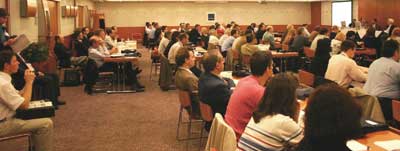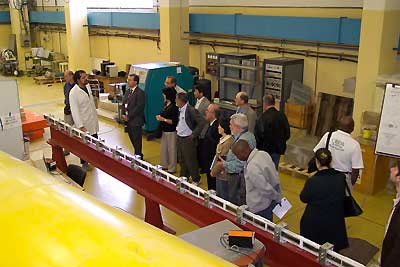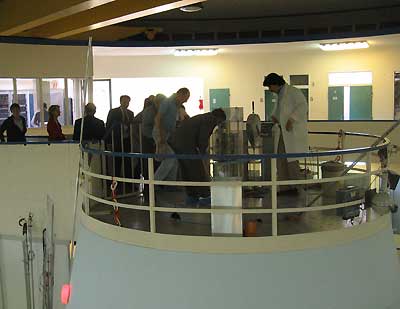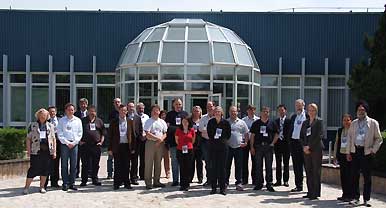
European
Nuclear Society
e-news
Issue 21 Summer 2008
http://www.euronuclear.org/e-news/e-news-21/ygn-reporter-nestet2008.htm


The first NESTet (Nuclear Engineering, Science and Technology – Education and Training) conference was held in Hungary, from 4-8 May. The first three days of the conference took place at the Novotel Budapest Centrum Hotel. Day four was set aside for technical tours.
After opening speeches from David Bonser, President of ENS, and Tamás Pázmándi, Chairman of the Hungarian Nuclear Society, the conference kicked off with the a presentation ceremony for the awarding of European Master of Science in Nuclear Engineering (EMSNE) diplomas for 2007. 11 students from 5 countries received their EMSNE 2007 diplomas.

Generally, the programme was divided into two sections - an industry oriented section and an education and training oriented one. The event also featured poster displays that took place on the Monday and on Tuesday, after the lunch break.
The Conference Dinner took place on the evening of the second
day at the Baroque Hall of Budapest Historical Museum, which is situated in
the Royal Palace of the Castle of Buda.
One of the main topics discussed during the conference was the problem of supplying
new professionals for the nuclear industry in the future. While arguments persist
about the role of nuclear energy in the context of future sustainability, a
new generation of scientists, engineers and technicians will, whatever happens,
always be needed to maintain the operation of existing nuclear facilities.
The problem is that in the current uncertain situation it is hard to predict
the future needs of the industry when it comes to recruiting new professionals.
It is also hard to make a career in the nuclear field appear attractive for
youngsters. For example, in Lithuania more than 80% of total electricity generation
is provided by the two units at Ignalina NPP, but now they are to be closed.
This means that after their total shutdown in 2009 a majority of the employees
will be made redundant. Plans to build new units are currently under discussion,
so the knowledge of those professionals who will lose their jobs will be required.
But it will prove a problem to retain these people in the nuclear industry
until that time. On the other hand, to provide the required amount of professionals
universities will have to train a new generation of workers for the nuclear
industry. So, they have to explore what skills and knowledge will be essential
for professionals over the coming years. But even if they produce a detailed
education and training programme the uncertain future of the nuclear industry
at the moment make it hard to persuade youngsters to sign up to a nuclear career.

The four-day conference finished with a choice of technical tour - either to the Budapest Research Reactor at the Central Research Institute of Physics (KFKI) or to the Paks NPP. The visit to the research reactor and the KFKI consisted of three parts. First, the leader of the Reactor Department, Sándor Tozsér, outlined the history of the reactor and showed us the control room. Secondly, short presentations about the utilisation possibilities (László Rosta) and research activities (Rózsa Baranyai) were given. The reactor hall was then visited. Next the visitors reviewed the instrumentation and were shown the main parts of the reactor, (it was not in operation at the time because of maintenance works). Finally, the last part of the visit was to the guide hall. Here cold and thermal neutron measurements are carried out with help the neutron guides.

The next stop on the technical tour was the training reactor at the Budapest University of Technology and Economics (BME). We visited the facility during "full operation" with several groups of students given laboratory exercises to carry out such as activation analysis. Our guides, Szabolcs Czifrus and András Csige, started with a short introduction about the history and the objectives of the training reactor. We then had the opportunity to visit the control room and the reactor podium, and to look inside the pool type reactor.
The other group spent the day at the Paks NPP. This tour started at the Simulator Center department, where István Frányó informed them about the training and testing of the main control room staff. He also explained the structure of the main control room simulator. Group Leader Csaba Dohóczki guided the visitors through the turbine hall and to the “visitors’ corridor” of the reactor halls of Units 1 and 2. In the afternoon Péter Lukács took the group round the Maintenance and Training Center, where it received valuable information about the training of primary circuit staff at Paks NPP. Finally, visitors were familiarized with current educational and training practices at the Paks.

The photos were taken by: Péter Tóth, Attila Madaras, Bogdán Yamaji.
© European Nuclear Society, 2008